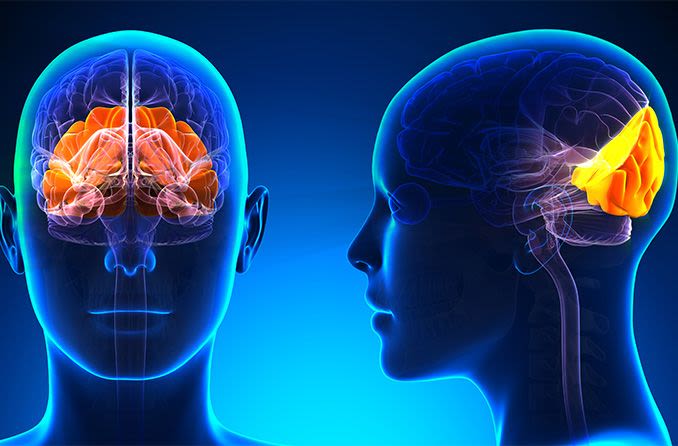Is eye contact important?
Eye contact (also known as “direct gaze”) is a valuable part of nonverbal communication. Our brains have developed to pay close attention to eye contact and the messages that it conveys. Through eye contact, we can gather communication cues about tone, emotional state, turn-taking and more.
While we don’t necessarily speak with our eyes, we use them to send and receive messages. For example, many of us have had a partner, sibling or friend give us a look that spoke for itself. But how big of a role does eye contact play in how we communicate?
To fully understand how eye contact is used in communication, it’s important to consider other factors as well. Cultural background and the specifics of a situation play key roles in how we interpret eye contact and what meaning it carries.
Eye contact meaning
At the most basic level, making eye contact with someone means you see them and acknowledge their presence. Eye contact may seem like a simple act, but it carries a different meaning depending on where you are in the world.
Western European cultures believe maintaining eye contact is a sign of respect. They’re also more likely to search for and detect eye contact during social interactions.
Eye contact is felt differently in many Eastern Asian cultures. People practice avoiding eye contact with others because it’s seen as disrespectful. Residents of Japan often teach their children to look at a person’s neck when they’re speaking to them. This still allows for the person’s face and eyes to fall within the child’s peripheral vision but is less direct than eye contact.
The effect eye contact has on the brain
Extensive research has been done on how the brain responds to eye contact. Linking eyes with someone — even if it’s a stranger — has a powerful effect on our focus ability, social development and anatomical response.
It’s hypothesized that the human eye's structure has evolved over time. The changes accommodate our need for social interaction and coordinated behavior with others.
Unlike that of other primates, the human eye has the brightness of the sclera (whites of the eye) contrasting with the darkness of the pupil. This contrast allows us to recognize which direction the eye is focused. It also helps us determine whether we have another person’s attention.
Research to better understand eye contact’s effect on human response found that:
Humans’ attention is more attracted by a face that’s looking at them than by a face that has an averted gaze.
Eye contact triggers higher skin conductance response. This is an electrochemical response to environment and emotion.
Heart rate decelerates in response to eye contact.
Eye contact triggers better visual event-related brain potentials. These are related to perceptual and cognitive brain functions.
Infants prefer faces that are making eye contact over faces that are not. This preference is present at birth.
Direct gaze enhances social cognitive functions, like empathy, joint attention and face memory.
One study measuring the brain’s reaction to eye contact found that parts of the brain lit up in response to eye contact. These areas controlled intentionality processing and cognitive tasks, such as:
Working memory
Decision making
Mood regulation
Timing
Novelty detection
This study also found that humans prefer eye contact over-focusing on a person’s mouth as they speak. This may suggest that mouth fixation stimulates the parts of the brain listed above, similar to the way that eye contact does.
SEE RELATED: The importance of eye contact for child development
Importance of eye contact in communication
It can be distracting when the person you’re talking to appears focused on something besides your conversation. This is because we rely on observing other people’s eyes to draw conclusions about their mental and emotional states and the focus of their attention.
Research suggests that we use our knowledge of eye function to decode eye behavior. For example, when the eyes are narrowed, it improves visual acuity so we can discriminate smaller details. So, when we see someone else narrow their eyes in response to something we said, we assume they are trying to analyze and better understand the details of the message.
SEE RELATED: Can eye movements indicate lying?
Similarly, we open our eyes wide to allow for more light, which can help us detect any potential threats. This function causes us to associate wide eyes with fear or shock.
Eye contact helps us understand the tone of the messages we send and receive. It also helps us navigate the conversation. During conversation, we keep track of the gaze signals we give off. At the same time, we're also decoding the gaze signals the other person is sending us.
It’s suggested that our gaze during conversation depends on the sub-task we’re performing: speaking or listening. People often look for eye cues to let them know when speaking will begin. As the person speaking sends gaze signals related to speaking, the person listening sends reception signals that communicate attention and engagement.
Making eye contact during conversation can notify the other person that your turn to speak is coming to an end and signals them to respond. It can also be used as a nudge to regain the attention of your conversation partner.
Research suggests that we use eye contact subconsciously, but precisely, throughout conversation. This is to make the most of the shared attention between parties. The more eye contact, the more engaged each party is in the conversation.
Social anxiety and eye contact
There are several reasons eye contact could make someone uncomfortable. However, avoiding direct gaze is a common characteristic of social anxiety.
Researchers have studied social anxiety and eye contact to gain an understanding of how a natural response can cause stress and fear in some.
People who have social anxiety disorder have a serious fear of being criticized. This causes them stress and self-consciousness in social situations.
They often have attentional bias when processing negative or rejection-related social cues. In other words, they are more likely to notice a negative cue over a positive one. Another characteristic of someone with social anxiety is to view unfamiliar social situations as threatening. This makes their experience of new and unfamiliar environments very stressful.
Other reasons someone avoids eye contact may include:
They experience fear associated with being the center of someone’s attention.
They feel overstimulated by keeping eye contact.
They deal with embarrassment, shame or self-consciousness, and eye contact raises those feelings.
They find it difficult to focus on what’s being said when concentrating on keeping eye contact.
They believe making eye contact puts them in a vulnerable position to be scrutinized.
It’s possible to manage social anxiety with prescription medication and/or therapy. As a more informal strategy, it is also entirely possible to have a conversation while making minimal eye contact. If someone you know lives with social anxiety and finds it difficult to keep eye contact, they will probably appreciate it if you don’t pressure them to do so. Instead, be patient and allow them to communicate in the way that makes them most comfortable. Just because they’re not looking into your eyes does not mean they’re not listening to you.
Eye contact practice
For those looking to improve their eye contact skills, try a few of these tips the next time you’re in a social setting.
Initiate eye contact in the beginning – Before the conversation begins, make eye contact with the person instead of looking down or at another object.
Keep eye contact for 4-5 seconds – Once you’ve made eye contact, maintain it for 4 to 5 seconds. Then, slowly glance away for a moment, and then reestablish eye contact.
Practice the 50/70 rule – When having a conversation, try to hold eye contact 50% of the time you’re speaking and 70% of the time you’re listening. This shows the person you’re speaking with that you’re engaged and interested in what they’re saying.
Keep in mind where you’re looking – During the times when you break eye contact, try to do so slowly. Darting the eyes quickly can be distracting for the other person. You should also make an effort to look to one side or the other. Looking downward communicates low confidence.
Speak and listen with your eyes – When you’re listening to someone who is speaking to you, it’s important to keep eye contact with them, just as you would if you were the one speaking. Feel free to smile, nod or use other expressions to let the other person know you’re engaged in the conversation.
These habits likely won’t develop overnight. It’s important to practice them with people you’re most comfortable with first. Over time, you’ll build confidence in making eye contact and building relationships with new people.
READ NEXT : Eye behaviors of psychopaths










